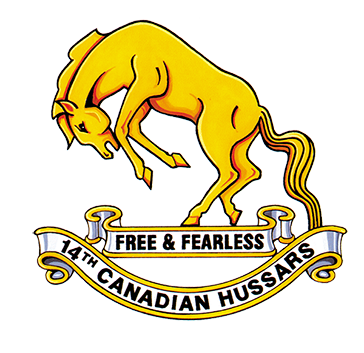14th Canadian Hussars
The official lineage of 14th Canadian Hussars infantry regiment.

Badge
Description
A bucking horse Or above a scroll Argent edged Or inscribed FREE and FEARLESS in letters Sable set on a like scroll inscribed 14TH CANADIAN HUSSARS.
Symbolism
The bucking horse is a symbol of the ranching country in which the regiment was raised. "14TH CANADIAN HUSSARS" is the regimental title and "FREE and FEARLESS" is the motto of the regiment.
Motto
FREE AND FEARLESS
March
Bonnie Dundee
Guidon
No Guidon recorded
Camp flag
No camp flag recorded
Battle honours
The First World War
YPRES, 1915, '17; FESTUBERT, 1915; ARRAS, 1917, '18; HILL 70; AMIENS; HINDENBURG LINE; PURSUIT TO MONS.
The Second World War
CAEN; FALAISE; Falaise Road; Clair Tizon; The Laison; The Seine, 1944; Antwerp-Turnhout Canal; THE SCHELDT; Woensdrecht; South Beveland; THE RHINELAND; Twente Canal; Groningen; Oldenburg; NORTH-WEST EUROPE, 1944-1945.
Lineage
This Reserve Force regiment originated in Saskatchewan on 1 April 1910, when the '27th Light Horse' was authorized to be formed.1 It was redesignated: '14th Canadian Light Horse' on 15 March 1920;2 '14th Canadian Hussars' on 1 August 1940;3 '2nd (Reserve) Regiment, 14th Canadian Hussars' on 11 February 1941;4 '8th (Reserve) Reconnaissance Battalion, (14th Canadian Hussars)' on 1 April 1941;5 '8th (Reserve) Reconnaissance Regiment, (14th Canadian Hussars), CAC' on 8 June 1942;6 '8th (Reserve) Reconnaissance Regiment, (14th Canadian Hussars), RCAC' on 2 August 1945;7 '8th Armoured Car Regiment (14th Canadian Hussars)' on 19 June 1947;8 '14th Canadian Hussars (8th Armoured Car Regiment)' on 4 February 1949;9 '14th Canadian Hussars (8th Armoured Regiment)' on 31 July 1954;10 and '14th Canadian Hussars' on 19 May 1958.11 It was reduced to nil strength and transferred to the Supplementary Order of Battle on 31 March 1968.12
Notes:
On 1 November 1920, the 14th Canadian Light Horse was organized as a two regiment unit with the 1st Regiment on the Non Permanent Active Militia order of battle, and the 2nd Regiment on the Reserve order of battle (GO 185/20). The reserve unit was disbanded on 14 December 1936 (GO 3/37).
The 14th Canadian Light Horse was disbanded for the purpose of reorganization on 15 April 1921 and reorganized the same day (GO 175/21). This change was administrative and does not affect the lineage of the regiment.
On 15 January 1930, the 1st Regiment was redesignated the 1st Regiment (209th Battalion, CEF) (GO 11/30). The reserve unit was disbanded on 14 December 1936 (GO 3/37).
Perpetuations
'209th "Overseas" Battalion, CEF'
Headquarters Location
Swift Current, Saskatchewan
Operational history
The First World War
Details of the 27th Light Horse were placed on active service on 6 August 1914 for local protection duties.13
The 209th Battalion, which was authorized on 15 July 1916 as the '209th "Overseas" Battalion, CEF',14 embarked for Britain on 1 November 1916.15 Its personnel were absorbed by the '9th Reserve Battalion, CEF' on 5 December 1916 to provide reinforcements for the Canadian Corps in the field.16 The battalion was disbanded on 21 May 1917.17
The Second World War
The regiment mobilized the '14th (Active) Canadian Hussars, CASF' for active service on 26 January 1941.18 It was converted to armour and redesignated: '8th Reconnaissance Battalion (14th Canadian Hussars), CASF' on 11 February 1941;19 '8th Reconnaissance Regiment (14th Canadian Hussars), CAC, CASF' 8 June 1942;20 and '8th Reconnaissance Regiment (14th Canadian Hussars), RCAC, CASF' on 2 August 1945.21 The unit was formed from personnel of the 2nd Canadian Infantry Division in England and reinforcements from Canada.22 It landed in France on 7 July 1944 as part of the 2nd Canadian Infantry Division, where it fought in North-West Europe until the end of the war.23 The overseas regiment was disbanded on 15 December 1945.24
Page details
- Date modified: